
Choosing the right glazing material for your greenhouse is one of the most important decisions you'll make during the planning process. Each option offers different benefits and trade-offs in terms of cost, durability, insulation, and light transmission.
Glass has been the traditional choice for greenhouses for centuries, and for good reason. It provides excellent light transmission, typically allowing 90-95% of available light to reach your plants. This superior light quality promotes healthy plant growth and is especially important for light-sensitive crops.
Glass is also incredibly durable and long-lasting. Unlike other materials, it won't yellow, cloud, or degrade over time. A well-maintained glass greenhouse can last for decades, making it a good long-term investment. However, glass is the most expensive option and requires a sturdy frame to support its weight.
The fragility of glass is its main drawback. It can break from hail, falling branches, or accidental impacts. In areas prone to severe weather, you might want to consider tempered or laminated glass for added safety. Glass also provides minimal insulation, which can lead to higher heating costs in cold climates.
Polycarbonate panels have become increasingly popular in recent years due to their excellent balance of properties. They offer good light transmission (80-90%) while providing superior insulation compared to glass. The multi-wall structure of polycarbonate creates air pockets that trap heat, reducing energy costs.
Durability is another major advantage of polycarbonate. It's virtually unbreakable and can withstand hail, wind, and impact damage that would shatter glass. This makes it an excellent choice for areas with severe weather or for families with children or pets.
Polycarbonate does have some limitations. It can yellow over time when exposed to UV light, though high-quality panels include UV inhibitors to minimize this effect. The material is also more prone to scratching than glass, so care should be taken during cleaning and maintenance.
Polyethylene film represents the most affordable option for greenhouse glazing. It's lightweight, easy to install, and provides good light transmission (85-90%). This makes it an excellent choice for temporary structures or for gardeners on a tight budget.
However, polyethylene has significant drawbacks that limit its long-term value. The material degrades quickly when exposed to UV light, typically requiring replacement every 2-5 years. It provides minimal insulation and is vulnerable to tears and punctures from wind, hail, or sharp objects.
For most permanent greenhouse installations, we recommend polycarbonate as the best overall choice. It offers the durability and insulation of more expensive materials at a reasonable price point. Glass remains the premium option for those who prioritize light quality and have the budget for it.
Your choice should ultimately depend on your specific circumstances: budget, climate, intended use, and how long you plan to keep the greenhouse. Consider not just the initial cost, but the long-term maintenance and replacement costs when making your decision.
